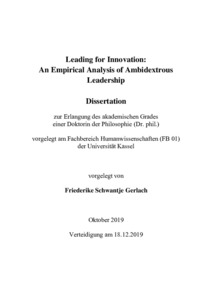| dc.date.accessioned | 2020-02-07T10:41:14Z | |
| dc.date.available | 2020-02-07T10:41:14Z | |
| dc.date.issued | 2019-10 | |
| dc.identifier | doi:10.17170/kobra-20200129969 | |
| dc.identifier.uri | http://hdl.handle.net/123456789/11452 | |
| dc.description.sponsorship | DFG (RO 4647/3-1) | |
| dc.language.iso | eng | |
| dc.rights | Urheberrechtlich geschützt | |
| dc.rights.uri | https://rightsstatements.org/page/InC/1.0/ | |
| dc.subject | leadership | eng |
| dc.subject | innovation | eng |
| dc.subject | ambidextrous leadership | eng |
| dc.subject | opening leader behavior | eng |
| dc.subject | closing leader behavior | eng |
| dc.subject | creativity | eng |
| dc.subject | implementation | eng |
| dc.subject | innovation requirements | eng |
| dc.subject | flexibility | eng |
| dc.subject.ddc | 150 | |
| dc.title | Leading for innovation: an empirical analysis of ambidextrous leadership | eng |
| dc.type | Dissertation | |
| dcterms.abstract | This dissertation investigates leadership in innovation processes. Based on ambidexterity theory, the focus is on the contradictory aspects of creativity and implementation within the innovation process and how leaders can support employees in addressing them. More specifically, this dissertation takes a within-process perspective looking at the influences of leader behaviors depending on different situations within the innovation process. The ambidextrous leadership model provides concrete leader behaviors defined to address the specifics of the innovation process. Thus, the relevance of these specific leader behaviors for the innovation process, i.e. opening and closing leader behaviors, is examined. Furthermore, the flexible adaptation of ambidextrous leader behaviors and the alignment of leader and follower behaviors with situational requirements of creativity and implementation is investigated. Three dissertation studies are described including a longitudinal field study across six weeks as well as two experimental designs manipulating leadership in the laboratory. The results emphasize the relevance of opening and closing leader behavior for leadership in innovation processes. Furthermore, it has been found that the alignment of leader and follower behaviors with situational requirements of creativity and implementation leads to higher innovation performance. Unfortunately, evidence for the flexible adaptation of ambidextrous leader behaviors was not provided. Nonetheless, this might be due to operationalizations of the flexibility component disregarding the alignment of leader behaviors with situational requirements. This dissertation adds to our understanding of leadership for innovation, because the within-process perspective for innovation is emphasized and provides evidence for the relevance of situational requirements of creativity and implementation. These aspects need to be considered by leaders to reach successful innovations. | eng |
| dcterms.accessRights | open access | |
| dcterms.creator | Gerlach, Friederike Schwantje | |
| dcterms.dateAccepted | 2019-12-18 | |
| dcterms.extent | 157 Seiten | |
| dc.contributor.corporatename | Kassel, Universität Kassel, Fachbereich Humanwissenschaften, Institut für Psychologie | |
| dc.contributor.referee | Rosing, Katharina (Jun.-Prof. Dr.) | |
| dc.contributor.referee | Ohly, Sandra ( Prof. Dr.) | |
| dc.contributor.referee | Gielnik, Michael (Prof. Dr.) | |
| dc.relation.issupplementedby | Material of the experimental set-up in the appendix | |
| dc.relation.projectid | DFG (RO 4647/3-1) | |
| dc.subject.swd | Beidhändigkeit | ger |
| dc.subject.swd | Flexibilität | ger |
| dc.subject.swd | Führung | ger |
| dc.subject.swd | Innovationsmanagement | ger |
| dc.type.version | publishedVersion | |

